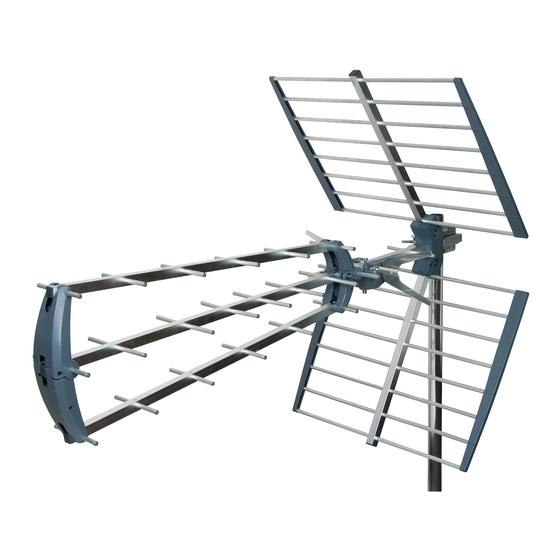
Advertisement
Labgear
Labgear
Congratulations on the purchase of your high gain digital aerial. The aerial is ideal for
the reception of all available signals in weak and fringe areas.
The aerial is of particularly robust construction to ensure a long operating life.
•
Ideal for fringe reception areas
•
Tilting mast clamp for easy adjustment
•
Easy dipole assembly
•
Unique compact folding design
•
High Gain: 16.5dB
Installation Instructions
For optimum results install the aerial using double screened digital coax
cable and screened coax outlets. You will need to fit the coax cable with an
F type connector to connect to the aerial balun.
1. Prepare the Coax Cable: Firstly fit the rubber weather boot
provided, to the aerial end of the cable. Strip the end of the cable
as shown in Fig. 1. Once you have stripped the cable, twist the
braid and pull it back on itself, make sure that no braid is
touching the copper core, this will cause a short on
the cable and you will not get any signal.
2. Fitting the F connector: Now, simply twist on the 'F'
connector and trim central conductor. Connect to the 'F'
socket on the aerial balun making sure that the weather boot is
correctly secured over the 'F' connector and socket - see Fig. 2.
The diagram above shows the aerial fully assembled and shows the direction
to unfold the booms prior to assembly
Wideband High Gain Digital Aerial
•
Front/Back Ratio: >28dB
•
Length: 1.25m
•
Electronic 75Ω balun
•
Connection: F type
Fig. 1
Fig. 2
screw connector
body onto cable
leave foil
in place
fold braid back
over sheath
6.5mm
8mm
inner
wire
end of
insulation
should be
flush with
this face
2mm approx.
Advertisement
Table of Contents

Summary of Contents for Labgear Wideband High Gain Digital Aerial
-
Page 1: Installation Instructions
Labgear Labgear Wideband High Gain Digital Aerial Congratulations on the purchase of your high gain digital aerial. The aerial is ideal for the reception of all available signals in weak and fringe areas. The aerial is of particularly robust construction to ensure a long operating life. -
Page 2: Troubleshooting
For best results the aerial should be mounted on an outdoor aerial mast and pointed in the direction of the nearest transmitter* making sure it is in a position where the transmitter signal will not be obstructed by nearby trees and buildings. If you are in any doubt about the direction in which the aerial should be pointing or the orientation of the aerial (horizontal for main transmitter, vertical for relay transmitter) check your neighbours’ aerials. Unfold the booms as shown overleaf 1a. Secure the booms at the front of the aerial using one of the bolts supplied with standard nuts. 1b. Secure the booms at the back of the aerial using the other bolt with a standard nut. 2. Fix the reflectors to the main boom as shown using the brackets and one of the bolts with wing nuts. 3. Next fasten the balun to the main boom using the other bolt with a wing nut. Make sure the F connector on the balun is facing towards the back of the aerial. 4. Connect to the ‘F’ socket on the aerial balun and slide the weather boot over the ‘F’ connector and socket to give a weather proof seal. 5. Use the mast clamp supplied to fix the aerial securely to the mast. 08457 573 479 Customer Careline: Troubleshooting No picture: Check all connections from aerial to TV. Local rate UK number, Monday to Friday 9am-5pm Poor picture: Check all connections from aerial to TV. E-mail Support: technical@philex.com Check aerial is properly aligned to the correct transmitter. If the aerial has been loft mounted try mounting outside. Other Useful Websites for Digital Advice: Make sure new digital coax cable has been used throughout *To confirm that your home is in a coverage area, to find the installation.











Need help?
Do you have a question about the Wideband High Gain Digital Aerial and is the answer not in the manual?
Questions and answers